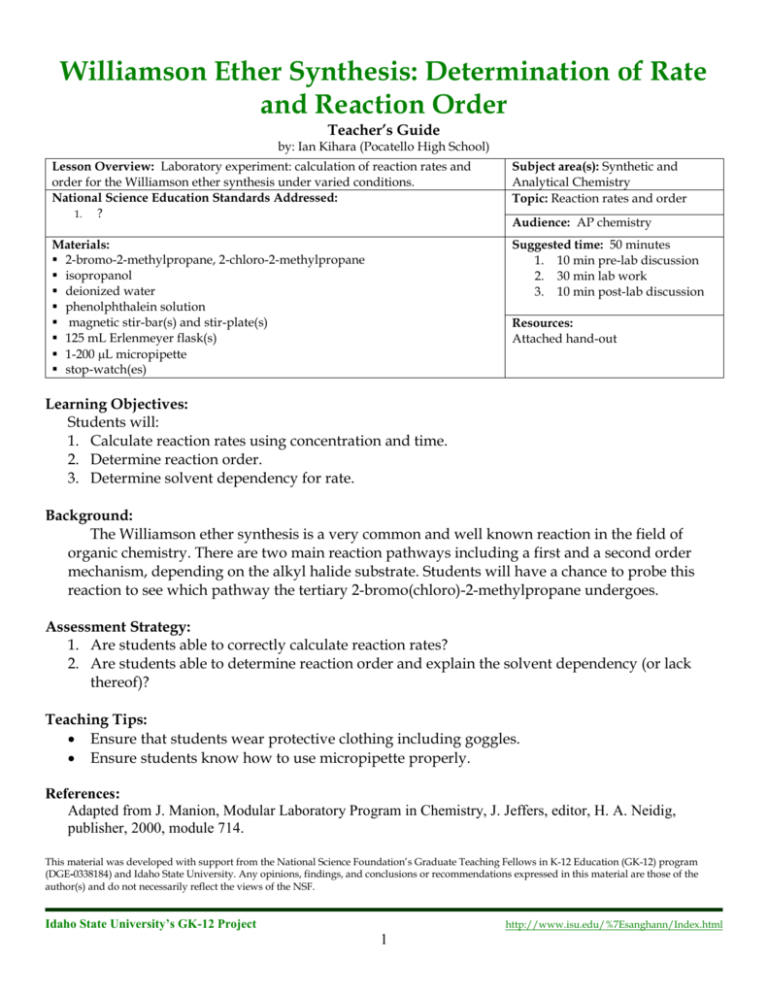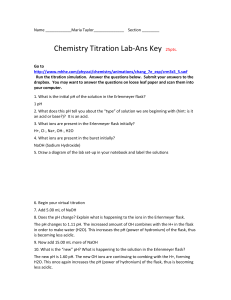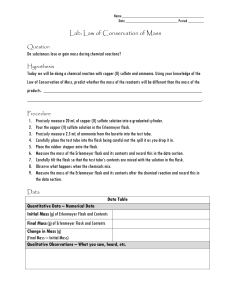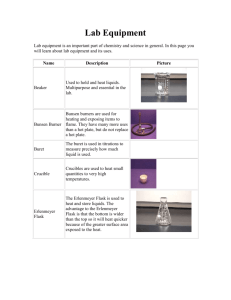Lesson Plan - Idaho State University
advertisement

Williamson Ether Synthesis: Determination of Rate and Reaction Order Teacher’s Guide by: Ian Kihara (Pocatello High School) Lesson Overview: Laboratory experiment: calculation of reaction rates and order for the Williamson ether synthesis under varied conditions. National Science Education Standards Addressed: 1. ? Subject area(s): Synthetic and Analytical Chemistry Topic: Reaction rates and order Materials: 2-bromo-2-methylpropane, 2-chloro-2-methylpropane isopropanol deionized water phenolphthalein solution magnetic stir-bar(s) and stir-plate(s) 125 mL Erlenmeyer flask(s) 1-200 L micropipette stop-watch(es) Suggested time: 50 minutes 1. 10 min pre-lab discussion 2. 30 min lab work 3. 10 min post-lab discussion Audience: AP chemistry Resources: Attached hand-out Learning Objectives: Students will: 1. Calculate reaction rates using concentration and time. 2. Determine reaction order. 3. Determine solvent dependency for rate. Background: The Williamson ether synthesis is a very common and well known reaction in the field of organic chemistry. There are two main reaction pathways including a first and a second order mechanism, depending on the alkyl halide substrate. Students will have a chance to probe this reaction to see which pathway the tertiary 2-bromo(chloro)-2-methylpropane undergoes. Assessment Strategy: 1. Are students able to correctly calculate reaction rates? 2. Are students able to determine reaction order and explain the solvent dependency (or lack thereof)? Teaching Tips: Ensure that students wear protective clothing including goggles. Ensure students know how to use micropipette properly. References: Adapted from J. Manion, Modular Laboratory Program in Chemistry, J. Jeffers, editor, H. A. Neidig, publisher, 2000, module 714. This material was developed with support from the National Science Foundation’s Graduate Teaching Fellows in K-12 Education (GK-12) program (DGE-0338184) and Idaho State University. Any opinions, findings, and conclusions or recommendations expressed in this material are those of the author(s) and do not necessarily reflect the views of the NSF. Idaho State University’s GK-12 Project http://www.isu.edu/%7Esanghann/Index.html 1 Williamson Ether Synthesis: Determination of Rate and Reaction Order OH H X H 3C C C CH3 CH3 X= Br, Cl H3C CH3 H3C CH3 C 0.5 M NaOH H2O, iPrOH H3C CH3 C H O CH3 Goals: To learn basic organic synthesis techniques Determine reaction order and rate under various reaction conditions Compare different reaction substrates References: Adapted from J. Manion, Modular Laboratory Program in Chemistry, J. Jeffers, editor, H. A. Neidig, publisher, 2000, module 714. Experimental: A.) Br vs. Cl Objective: Determine reactivity difference between halide substituents. Materials: 2-bromo-2-methylpropane, 2-chloro-2-methylpropane 2-propanol, D.I. water phenolphthalein solution magnetic stir-bars and stir-plate 125 mL Erlenmeyer flask stopwatch Procedure: To a clean Erlenmeyer flask equipped with a magnetic stir-bar add 50 mL 2-propanol and 50 mL deionized water. To the flask add 5 drops of phenolphthalein solution and 200 L of 0.50 M NaOH. Add to the flask 50L of 2-bromo-2-methylpropane, immediately start timing and place on the stir-plate. After the reaction time is taken, clean the flask and stirbar with deionized water and repeat the experiment with 2-chloro-2-methylpropane. Idaho State University’s GK-12 Project http://www.isu.edu/%7Esanghann/Index.html 2 Questions: 1. What were the respective reaction rates? 2. What might explain this difference? B.) Reaction order (two groups) Objective: Determine reaction order with respect to each substrate. Materials: 2-bromo-2-methylpropane 2-propanol, D.I. water phenolphthalein solution magnetic stir-bar and stir-plate 125 mL Erlenmeyer flask stopwatch Procedure: To a clean Erlenmeyer flask equipped with a magnetic stir-bar add 2-propanol and deionized water. To the flask add 5 drops of phenolphthalein solution and 0.50 M NaOH. Add to the flask 2-bromo-2-methylpropane, immediately start timing and place on the stirplate. After the reaction time is taken, clean the flask and stir-bar with deionized water and continue to the next experiment. Group 1 (2-bromo-2-methylpropane): Reaction 1 60 L 0.5 M NaOH 200 L 2-propanol 25 mL D.I. water 75 mL tBuBr Reaction 2 30 L 200 L 25 mL 75 mL Reaction 3 120 L 200 L 25 mL 75 mL Questions: 1. What were the respective reaction rates? 2. What was the reaction order with respect to tBuBr? C.) Solvent Dependency Objective: Determine rate dependence on solvent. Materials: 2-bromo-2-methylpropane 2-propanol, D.I. water phenolphthalein solution magnetic stir-bar and stir-plate Idaho State University’s GK-12 Project http://www.isu.edu/%7Esanghann/Index.html 3 125 mL Erlenmeyer flask stopwatch Procedure: To a clean Erlenmeyer flask equipped with a magnetic stir-bar add 2-propanol and deionized water. To the flask add 5 drops of phenolphthalein solution and 0.50 M NaOH. Add to the flask 2-bromo-2-methylpropane, immediately start timing and place on the stirplate. After the reaction time is taken, clean the flask and stir-bar with deionized water and continue to the next experiment. Reaction 1 50 L 0.5 M NaOH 200 L 2-propanol 30 mL D.I. water 70 mL tBuBr Reaction 2 50 L 200 L 50 mL 50 mL Reaction 3 50 L 200 L 70 mL 30 mL Questions: 1. What were the respective reaction rates? 2. Did the reaction appear to be dependant on the solvent mixture? 3. What physical property could have contributed to this? Why? This material was developed with support from the National Science Foundation’s Graduate Teaching Fellows in K-12 Education (GK-12) program (DGE-0338184) and Idaho State University. Any opinions, findings, and conclusions or recommendations expressed in this material are those of the author(s) and do not necessarily reflect the views of the NSF. Idaho State University’s GK-12 Project http://www.isu.edu/%7Esanghann/Index.html 4








